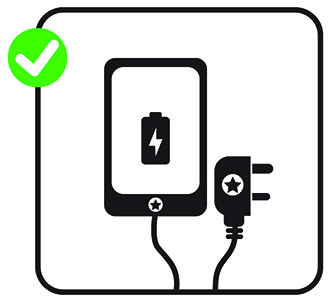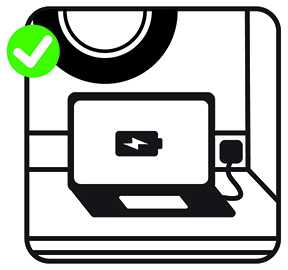Everyday portable devices powered by lithium-ion batteries
Fire safety for phone, laptop and other devices, their batteries & chargers

Download the PDF for Small Lithium-ion Powered Device Safety
Many small portable devices contain lithium-ion batteries, here’s a guide to their safe use. These are lightweight, rechargeable batteries
used safely by millions of people every day to power our phones, tablets, laptops, toothbrushes, watches, cameras and powerpacks.
However, there are some things you need to know when it comes to fire safety, chargers and lithium-ion batteries.
When appropriately used, lithium-ion batteries in small portable devices are free of fire risks, however the fire risk increases when they are damaged, e.g. crushed, punctured or immersed in water.
Safe charging is critical to protecting you and your crew.
Basic fire safety tips
Keep all escape routes clear at all times, lithium-ion battery fires can spread rapidly and traditional fire extinguishers may not work.
If a device or battery starts making loud popping, hissing or screaming sounds, or emits toxic vapour/smoke, or catches fire, raise the alarm, warn others, get out, stay out and call 999/ch16 for help immediately.
|
Install/ test smoke alarms: Create a safe escape plan: |
 |
How to stay safe - 12 golden rules for using and charging your devices safely
Battery and devices care and protection
|
1. Avoid Extreme Temperatures
|
2. Protect lithium-ion batteries 3. Only use kit in perfect condition 4. Dispose of lithium-ion batteries and devices carefully |
Safe Charging
|
5. Always use the original charger. Use the charger that came with your device. Buy replacement batteries or chargers from suppliers you trust and choose a genuine, branded product. |
6. Always charge batteries on stable surfaces, such as a galley worktop, but away from combustible materials |
|
|
|
|
7. Always be aboard, awake and alert, when charging your devices, and take them off charge as soon as the batteries are full. 8. Never cover chargers or charging devices The heat build-up could cause a fire and so never fall asleep with your charging phone or laptop under your pillow or duvet. |
9. Never block your escape. Always charge batteries away from your planned emergency escape routes. 10. Don’t overload electrical sockets. Ideally keep to one plug per socket. |
|
|
|
|
Be alert to early warning signs 11. Watch Out for Warning Signs. Know the critical warning signs of battery failure. If any are happening, turn off the power. Do not use it again and seek help from the supplier or manufacturer:
|
12. If the following warning signs are happening, get out and get off the boat (see escape plan above)
|






